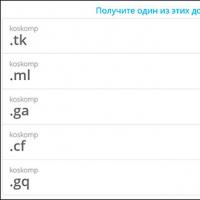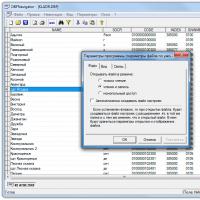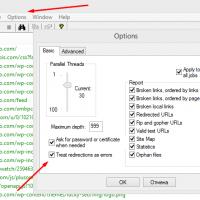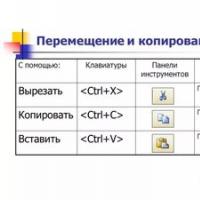Poor takes a radio racing 800. Setting the wagon megal. Key Pressing Sound
So, you purchased the MegaJet radio station installed it in the car. And now you have the most interesting thing - it is to configure it. But how to do that? The method of arbitrary pressing the buttons will not work. Read the instructions that are shot by scientific radio engineering terms, is also not very interesting and takes time. We offer you a small article with practical tips on setting up your radio station:
- First of all, you need to translate the radio to 240 channels mode. To do this, enter the combination "AM / FM -\u003e ON";
- If you incorrectly pressed the buttons, you can reset all settings, to reset the settings you need to click "CH9 -\u003e ON", "RESET" will appear on the screen;
- To go to the Russian grid, you need to dial the "DW / M2-\u003e ON" combination. After that, on the screen it will be possible to see that the frequencies end on 0. At the euro-grid, the frequency ends on 5, we draw your attention that most often drivers and truckers use it precisely the mesh of the European range;
- You can check the radio in this way by including, for example, a channel for truckers C15E AM at a frequency of 27.135, where "C" is a grid, "15" - channel number, "E" - a mesh of the European range, "AM" is amplitude modulation;
- You can configure the antenna yourself. You can set the native antenna or purchase another brand compatible with your radio station.
For the full setting of your radio station, in any case, you need to read the instructions or use the help of specialists.
But if you do not want to deal with the instructions or you just do not have time for it, then we propose to use the services of our specialists to set up and programming radio stations. They will professionally work in a short time, will give you valuable recommendations and tips on how to use.
Instructions for applying a car transceiver SIBI band MegaJet MJ-800
Before using the MEGAJET MJ-800 radio station, read this technical description.
Specifications and distinctive features
General
|
Frequency stabilization |
Frequency Synthesizer with PLG and Quartz Stabilization |
|
Receiver scheme |
SuperGetherodine with double conversion |
|
Supply voltage |
13.8 VOLT. |
|
Working temperature, |
10 ~ +50 hail Celsius |
|
Range of operating frequency |
25.615 ~ 28.305 MHz (240CH) |
|
Modulation type |
Transmitter
|
Output power |
FM: 8 Watt. AM: 8 Watt |
|
Frequency stability |
|
|
Modulation coefficient in Am. |
|
|
FM frequency deviation |
Receiver
|
Sensitivity |
AM: 0.5 UV (S / N LODB) |
|
Threshold of automatic noise reducer |
|
|
Signal / noise ratio |
|
|
The level of nonlinear distortions |
|
|
Maximum sound power |
Dimensions and weight
Operational parameters
|
Supply voltage |
10.5 ~ 15.0 Volt, minus on the case |
|
Consumable current |
No more than 2.5 amps |
|
Wave resistance antenna |
|
|
Resistance external loudspeaker |
At least 8 ohm |
|
138 x 159 x 48 mm |
|
|
Common weight with packaging |
Main features and functions
Compact design
Non-volatile channel memory
Separate frequency synthesizer on LC 7152 microcircuit
Front panel with large LCD display and LED backlit blue
Adjustable automatic noise cancel
Reliable tangent with dynamic microphone DS-3051-150 OHM
Memorization feature of the main working channel and quick access to it
Scan mode (SCAN)
Double reception mode (SW)
Indicator of the level of reception and transmission signals
Two-stage adjustment of the sensitivity of the receiver.
Emergency Setting on the 9th Channel (CH9)
Fast Sound Turning Function (MUTE)
Transmission Time Limit Function (TIMEOUT TIMER - TOT)
Sound confirmation function of keystrokes (BP)
ROGER BEEP Sound Confirmation Function
Ability to connect an external loudspeaker
Channel / Frequency Indication (FR)
Three cell memory cells.
Backlight control buttons
Description of the controls on the front panel of the radio station
1) Regulator Vol./ ON.. Designed to turn on / off the radio station and volume adjustment.
2) Regulator SQ.. Designed to adjust the threshold of noise cancellation.
3) Switch Channels Ch.
4) Button F.C. / SC. Thanks to this button, most function keys have a second function. For example, if you directly use the button BP. / RB.You can enable / disable the sound confirmation mode of pressing the buttons. If you first click the button F.C. / SC, and then BP. / RB.This will include / disable the sound confirmation mode. Also, this button turns on / off scanning mode.
5) Button SCH / SW. Turn on the operating channel and turn on / off the alternate scanning of the main / operating channels
6) Button BP. / RB.turning on / off sound confirmation Pressing the on / off buttons sound confirmation of the transmission.
7) Button Tot. / M.1 – transmission Time Limit / Memory 1
8) Button A./ F. / M.2 switches modulation type AM./ FM. / Memory 2.
9) Button Ch9 / M.3 - Enabling emergency 9 channel / Memory 3
10) Button Mu. / LO. – turning off the sound / reduction of the sensitivity of the receiver
11) Button LCr. / Fr. - Previous channel memory / frequency indication
Description of the controls on the microphone of the radio station
1) Button Up.switches the channels up.
2) Button DN.switches the channels down.
3) Button AQ.includes / turns off the fixed noise reduction threshold.
The procedure for working with a radio station
1. Inclusion of the radio station
Before turning on the radio station, make sure that the power cord is connected to it, the antenna connector and the microphone connector. Turn on the Station Handle Vol / O.N.By turning it clockwise until it clicks. On the display for 1 second all characters will appear, after which the channel number will appear and the character. AM." or " FM.” .
2. Installing the working channel.
Working channel is installed by a handle “ Ch”. The rotation of this handle clockwise increases the channel number, counterclockwise reduces. You can also change the working channel with buttons. “ Up.” (up) and “ DN.” (down) located on the tangent (microphone).
3. Switching the modes "40/240 channels" and installing a working grid.
To go from a 40-channel mode to a 240-channel, you must turn off the radio station with the handle Vol / O.N., at the same time press the buttons SCH / SW.and Tot. / M.1 And, without letting them, turn on the station. When you turn on the 240-channel mode next to the channel number appears from " A.” before " F.", Showing the work grid. Fuck grids Use the button CH9/ M3.
4. Setting the reception volume. Quick sound shutdown (Mute.).
Admission volume is adjusted by a handle Vol / O.N.. Noise cancellation threshold is regulated by a handle “ SQ.”. The noise reduction system removes the noise background in the absence of a useful signal. Install the handle “ SQ.” In the leftmost position, the noise background will be heard. Handle volume Vol / O.N. Set the desired volume level.
To quickly disconnect the sound (for example, with an incoming phone call) briefly press the button Mu. / LO.. In this case, the symbol of the crossed speaker will appear. To turn on the sound back, press the button again. Mu. / LO..
5. Using automatic noise reduction.
Automatic noise cancellation mode provides the reception of the expected radio at the movement of a car in difficult urban environments, when the driver's attention should be most focused on the folding road atmosphere and traffic safety. In this mode, the radio station monitors the rapidly changing levels of external noise and interference of the industrial city and automatically adjusts the threshold of the noise reducer to the useful signal, without distracting the driver's attention to this.
Turn the handle “ SQ.” in the leftmost position. In this case, the noise reducer will turn off, and noise background will appear in the dynamics. Slowly turn the handle “ SQ.” clockwise until the noise background disappears. In this position, the receiver will be silent in the absence of a signal, however, a useful signal with a level that is slightly higher than noise levels, overcomes the effect of the noise-fluid and will be heard. With a further turn of the handle, the effect of the noise-lifter is increasingly growing, and a stronger signal is needed for overcoming it. In order to take weak signals or disable noise reduction scheme, turn the knob to the end counterclockwise.
In ASQ mode, the manual knocker knob is disabled, and the noise cancellation level is set to the average value. Turning on and off the ASQ mode is made from the headset with the button AQ.. When you turn on the ASQ, a symbol appears on the display. “ A.. SQ.” .
6 . Setting the modulation type.
Use the button to switch the modulation type A./ F. / M.2 At the same time, the symbol is displayed on the display. “ AM.” when the amplitude modulation is turned on, or “ FM.” when you turn on frequency modulation.
ATTENTION!!! At all your stations there must be the same mode of operation,
either fm or am .
7. Transmission.
For "transmission", press the transmission key on the microphone, while the transmitted power meter (RF) at the bottom of the display will show the relative level of output power. Speak into the microphone, holding it at a distance of ~ 10 cm from the face. Speak by a normal voice, do not shout. When you pass, the receiver is turned off - the reception is not possible. Similarly, your signal cannot be received by another station if it works in transmission mode. You need to talk and listen in turn. To go to the reception mode, simply release the tangent on the microphone.
ATTENTION!!! Work on the transmission with a disabled or unconfigured antenna is not allowed and can damage your radio station .
Sometimes the transmission key may accidentally be pressed for a long time. This creates interference with other correspondents operating in the same channel as you, and can also lead to the failure of your radio station due to overheating. To prevent such cases, the TOT function serves (Timeout Timer). To turn it on briefly press the button. Tot. / M.1, and the "TOT" symbol will appear on the display. Now the continuous operation of the radio station to the transmission will not exceed 3 minutes, after which the transmitter will automatically turn off, and the "TOT" symbol will begin to blink. Disable the function by repeated short-term press button Tot. / M.1.
8. Working with "Memory M1 ... M3".
Record in memory.
Select the desired channel that you want to "remember" in one of the three memory cells. Press and release the button F.C. / SC. Then press and hold the selected memory cell M1 ~ M3.. At the end of the recording, the confirmation signal will be distributed - BIP, and the corresponding symbol appears on the display - Me.and 1, 2 or 3
Call from memory.
Press and release the button F.C. / SC. Then the required memory cell M1 ~ M3.
9. Using the memory of the working channel.
If you often have to work in some specific channel, you can assign it as a "working channel". Press the button to turn on the working channel. SCH / SW., a symbol appears on the display. SCHand the number of the working channel. To change the operating channel number, press and hold the button. SCH / SW. About 5 seconds until the channel number starts blinking. Having setting the operating channel number you need (switch Ch) and the grid (button CH9 / M3.), Remember it short-term press button SCH / SW. . When working in mode SCH (working channel) All radio stations are blocked, with the exception of the Transmission key and the buttons SCH / SW. . This is done to eliminate the change in the radio station settings when accidentally pressing the buttons on the front panel or on the microphone . To disable the "Opening Channel" mode, click SCH / SW. .
10. Alternate listening to two channels.
Indication of sign " S.W " Means the inclusion in the radio station of the functional mode of the alternate listening of two channels. To enable this feature, set one of two channels. Another channel set as a "working channel" (see P.9). Briefly press the button F.C. / SC, and then SCH / SW.. Re-pressing these buttons disables the function. If listening has been suspended on a specific channel that is engaged in the correct corresponding, click the tangent for the session. At the same time, scanning stops, and the radio station goes into transmission mode.
11. Scan.
Indication of sign "SC" Means the operation of the receiver in the automatic scan mode. To implement this feature, turn on the power supply of the radio station and set the required volume. Adjust the noise reduction or turn on the fixed noise reduction of ASQ. Double-click the button. F.C. / SC, and scan will begin. A sign will appear on the display. "SC". When the channel is detected, the signal in which exceeds the level of the noise-cancelor, the scanning stops and resumes again after the signal is lost, up to the press of the tangent or dual pressing the button F.C. / SC.
12. Memory of the previous channel.
You can quickly return to that channel in which the last time worked for the transfer. To do this, briefly press the button. LCr. / Fr..
13. Indication of the channel / frequency number.
With a sequential short-term press of the buttons F.C. / SCand LCr. / Fr. Instead of the channel number, an operating frequency appears on the display. When you press these buttons again, the channel number and the grid will again be displayed.
14. Reducing the sensitivity of the receiver (mode "Local"-" Local reception ").
If in the channel where you are working, there are distant or weak radio stations that interfere with you, and the noise-cancel adjustment is not enough for them to not be heard, you can reduce the sensitivity of the receiver, turning on the "Local" mode - "local reception". To do this, briefly press the button. F.C. / SC, and then Mu. / LO., And the symbol will appear on the display. LO.". In this mode, you will hear the signals of only powerful or closely located radio stations. To return to normal mode, press F.C. / SC, and then Mu. / LO., symbol " LO."At the same time goes out.
15. Sound accompaniment keystrokes.
Briefly press the button BP. / RB.A symbol appears on the display. BP., indicating the keystroke mode indicating the keystroke mode. To disable this mode, again briefly press the button. BP. / RB.
16. Sound confirmation of the end of the transmission.
Briefly press the button F.C. / SCand then button BP. / RB.A symbol appears on the display. RB., dignifying the inclusion of the sound confirmation mode. To disable this mode, briefly press the button. F.C. / SCand then button BP. / RB.
17 . Return to factory settings.
If the station works incorrectly, or you want to clear the channel memory cells and return to the factory settings, turn on the radio station with the handle Vol / O.N.holding down the button Ch9 / M.3, while the display does not appear “ rset.”.
Description of the controls on the microphone of the radio station
1) Button Up.switches the channels up.
2) Button DN.switches the channels down.
3) Button AQ.includes / turns off the fixed noise reduction threshold.
The procedure for working with a radio station
1. Inclusion of the radio station
Before turning on the radio station, make sure that the power cord is connected to it,
antenna connector and microphone connector. Turn on the Station Handle Vol / ON.by turning it clockwise
arrow to click. On the display for 1 second all characters will appear, after which the number will appear.
channel and symbol " AM." or " FM.” .
2. Installing the working channel.
Working channel is installed by a handle "CH".Rotation of this handle clockwise
increases the channel number, counterclockwise reduces. You can also change
operating channel buttons "Up"(up) and "DN"(down) located on the tangent (microphone).
3. Switching the modes "40/240 channels" and installing a working grid.
To go from a 40-channel mode to a 240-channel, you must turn off
radio station handle VOL / ON,at the same time press the buttons SCH / SW.and TOT / M1. and without letting
them, turn on the station. When you turn on the 240-channel mode next to the channel number will appear
symbol from " A "before " F.", Showing the work grid. Fuck grids Use the button
CH9 / M3.
4. Setting the reception volume. Fast Sound Disconnection (MUTE).
Admission volume is adjusted by a handle Vol / ON.. Noise cancellation threshold is regulated
handle "SQ".The noise reduction system removes the noise background in the absence of a useful signal.
Install the handle "SQ" In the leftmost position, the noise background will be heard. Handle
volume Vol / ON. Set the desired volume level.
To quickly disconnect the sound (for example, with an incoming phone call)
briefly press the button Mu / Lo.In this case, the display will appear crossed
dynamics. To turn on the sound back, press the button again. Mu / Lo.
5. Using automatic noise reduction.
The automatic noise reduction mode provides the reception of the expected radio.
driving a car in difficult urban environments when the driver's attention should be
major focused on the folding road atmosphere and traffic safety.
In this mode, the radio station tracks rapidly changing levels of external noise and
interference of the industrial city and automatically adjusts the triggering threshold
noise-cancel on a useful signal, without distracting the driver's attention.
Turn the handle "SQ"in the leftmost position. In this case, the noise reducer will turn off and in
the dynamics will appear noise background. Slowly turn the handle "SQ"clockwise while
noise background will not disappear. In this position, the receiver will be silent in absence
signal, however, a useful signal with a level slightly exceeding noise levels, overcomes
the effect of the noise-cancel will be heard. With further turn handle action
the noise reducer is increasingly growing, and need a stronger signal to overcome it. For
to take weak signals or turn off the noise reduction scheme, turn the knob to
end counterclockwise.
In ASQ mode, the manual knocker regulator is turned off, and the noise reduction level
installed in the average value. Includes and turning off the ASQ mode is made with
headset button AQ.. When you turn on the ASQ, a symbol appears on the display. "A.sq".
MEGAJET MJ-800 Operating Instructions. RO F I.R U Description of the controls on the front panel of the radio station www.radioprofi.ru Ra di Op 1) VOL / ON regulator. Designed to turn on / off the radio station and volume adjustment. 2) SQ regulator. Designed to adjust the threshold of noise cancellation. 3) CH channel switch. 4) FC / SC button. Thanks to this button, most function keys have a second function. For example, if you use the BP / RB button directly, you can turn on / off the sound confirmation mode of pressing the buttons. If you first press the FC / SC button, and then BP / RB, then it will turn on / off the mode of sound confirmation of the transmission. Also, this button turns on / off scanning mode. 5) The SCH / SW button on the operating channel and turn on / off the alternate scanning of the main / operating channels 6) The BP / RB button on / off sound confirmation of the buttons and turn on / off sound confirmation of the transmission. 7) Button TOT / M1 - Transmission Time Limit / Memory 1 8) Button A / F / M2 Switches AM / FM Modulation View / Memory 2 9) CH9 / M3 Button - Enable Emergency 9 Channel / Memory 3 10) MU / LO button - Turning off the sound / decreased sensitivity of the receiver 11) LCR / FR button - memory of the previous channel / Frequency display Description of the controls on the microphone of the radio station 1) The UP button switches the channels up. 2) The DN button switches the channels down. 3) The AQ button turns on / off the fixed noise reduction threshold. Procedure for working with a radio station 1. Enable a radio station Before turning on the radio station, make sure that the power cord is connected to it, the antenna connector and the microphone connector. Turn on the VOL / ON handle station by turning it clockwise until it clicks. All characters will appear on the display for 1 second, after which the channel number and the "AM" or "FM" character appears. 2. Installing the working channel. I.R U The working channel is installed by the "CH" knob. The rotation of this handle clockwise increases the channel number, counterclockwise reduces. You can also change the working channel with the "Up" buttons (up) and "DN" (down) located on the tangent (microphone). 3. Switching the modes "40/240 channels" and installing a working grid. RO F To go from a 40-channel mode to a 240-channel, you must turn off the radio station with the VOL / ON knob, simultaneously press the SCH / SW and TOT / M1 buttons and, without releasing them, turn on the station. When you turn on the 240-channel mode next to the channel number, a symbol from "A" to "F" appears, showing the work grid. To switch grids, use the CH9 / M3 button. RA Di Op www.radioprofi.ru 4. Installing the reception volume. Fast Sound Disconnection (MUTE). The reception volume is adjusted by a VOL / ON knob. Noise cancellation threshold is regulated by a "SQ" knob. The noise reduction system removes the noise background in the absence of a useful signal. Install the "SQ" knob to the leftmost position, the noise background will be heard. VOL / ON knob Set the desired volume level. To quickly disconnect the sound (for example, with an incoming phone call), briefly press the MU / LO button. In this case, the symbol of the crossed speaker will appear. To turn on the sound back, press the MU / LO button again. 5. Using automatic noise reduction. Automatic noise cancellation mode provides the reception of the expected radio at the movement of a car in difficult urban environments, when the driver's attention should be most focused on the folding road atmosphere and traffic safety. In this mode, the radio station monitors the rapidly changing levels of external noise and interference of the industrial city and automatically adjusts the threshold of the noise reducer to the useful signal, without distracting the driver's attention to this. Turn the "SQ" knob to the leftmost position. In this case, the noise reducer will turn off, and noise background will appear in the dynamics. Slowly turn the "SQ" knob clockwise until the noise background disappears. In this position, the receiver will be silent in the absence of a signal, however, a useful signal with a level that is slightly higher than noise levels, overcomes the effect of the noise-fluid and will be heard. With a further turn of the handle, the effect of the noise-lifter is increasingly growing, and a stronger signal is needed for overcoming it. In order to take weak signals or disable noise reduction scheme, turn the knob to the end counterclockwise. In ASQ mode, the manual knocker knob is disabled, and the noise cancellation level is set to the average value. Turning on and off The ASQ mode is made from the headset with the AQ button. When you turn on the ASQ, the "A.SQ" symbol appears on the display. 6. Setting the modulation type. To switch the modulation type, use the A / F / M2 button, and the "AM" symbol is displayed on the display when the amplitude modulation is turned on, or "FM" when the frequency modulation is turned on. ATTENTION!!! At all your stations there must be the same mode of operation, or FM, or AM. 7. Transmission. For "transmission", press the transmission key on the microphone, while the transmitted power meter (RF) at the bottom of the display will show the relative level of output power. Speak into the microphone with a normal voice, holding it at a distance of ~ 10 cm from the face. . You need to talk and listen in turn. To go to the reception mode, simply release the tangent on the microphone. I.R U ATTENTION !!! Work on the transmission with a disabled or unconfigured antenna is not allowed and can damage your radio station. RO F Sometimes the transmission key may accidentally be pressed for a long time. This creates interference with other correspondents operating in the same channel as you, and can also lead to the failure of your radio station due to overheating. To prevent such cases, the TOT function serves (Timeout Timer). To turn on it, briefly press the TOT / M1 button, and the "TOT" symbol will appear on the display. Now the continuous operation of the radio station to the transmission will not exceed 3 minutes, after which the transmitter will automatically turn off, and the "TOT" symbol will begin to blink. Disable the function by repeated short-term pressing of the TOT / M1 button. RA Di Op www.radioprofi.ru 8. Working with "Memory M1 ... M3". Record in memory. Select the desired channel that you want to "remember" in one of the three memory cells. Press and release the FC / SC button. Then press and hold the selected memory cell M1 ~ M3. Upon completion of the recording, the confirmation signal will be distributed - BIP, and the corresponding character - ME and 1, 2 or 3 call from memory appears on the display. Press and release the FC / SC button. Then briefly press the button of the required memory cell M1 ~ M3. 9. Using the memory of the working channel. If you often have to work in some specific channel, you can assign it as a "working channel". To turn on the working channel, press the SCH / SW button, the SCH character appears on the display and the operating channel number. To change the operating channel number, press and hold the SCH / SW button for about 5 seconds until the channel number starts blinking. By setting the operating channel number you need (switch CH) and the grid (CH9 / M3 button), remember it short-term pressing the SCH / SW button. When working in SCH mode (operating channel), all the radio stations are blocked, with the exception of the Transmission key and the SCH / SW buttons. This is done to eliminate the change in the radio settings when accidentally pressing the buttons on the front panel or on the microphone. To disable the "Work Channel" mode, press the SCH / SW button. 10. Alternate listening to two channels. The sign indication "SW" means inclusion in the radio station of the functional mode of the alternate listening of two channels. To enable this feature, set one of two channels. Another channel set as a "working channel" (see P.9). Briefly press the FC / SC button, and then SCH / SW. Re-pressing these buttons disables the function. If listening has been suspended on a specific channel that is engaged in the correct corresponding, click the tangent for the session. At the same time, scanning stops, and the radio station goes into transmission mode. 11. Scan. Indication of the SC sign indicates the operation of the receiver in automatic scanning mode. To implement this feature, turn on the power supply of the radio station and set the required volume. Adjust the noise reduction or turn on the fixed noise reduction of ASQ. Twice briefly press the FC / SC button, and the scan will start. The "SC" sign appears on the display. When a channel is detected, the signal in which exceeds the level of the noise-precipient, the scanning stops and resumes again after the signal is lost, down until the tangent is pressed or the double press of the FC / SC button. I.R U 12. Memory of the previous channel. You can quickly return to that channel in which the last time worked for the transfer. To do this, briefly press the LCR / FR button. Ro F 13. Indication of the channel / frequency number. With a sequential short-term press of the FC / SC and LCR / FR buttons, the operating frequency appears instead of the channel number on the display. When you press these buttons again, the channel number and the grid will again be displayed. RA DI OP www.radioprofi.ru 14. Reducing the sensitivity of the receiver ("Local" mode - "local reception"). If in the channel where you are working, there are distant or weak radio stations that interfere with you, and the noise-cancel adjustment is not enough for them to not be heard, you can reduce the sensitivity of the receiver, turning on the "Local" mode - "local reception". For this, briefly press the FC / SC button, and then MU / LO, and the "LO" symbol will appear on the display. In this mode, you will hear the signals of only powerful or closely located radio stations. To return to normal mode, press FC / SC, and then MU / LO, the "Lo" symbol will go out. 15. Sound accompaniment keystrokes. Briefly press the BP / RB button. The BP symbol appears on the display, indicating the keystroke mode for pressing the keystroke. To disable this mode, again press the BP / RB button 16. Sound confirmation mode of the transmission. Briefly press the FC / SC button, and then the BP / RB button. The RB character appears on the display, indicating the inclusion of sound confirmation mode. To disable this mode, briefly press the FC / SC button, and then the BP / RB button. 17. Return to factory settings. If the station does not work correctly, or you want to clear the channel memory cells and return to the factory settings, turn on the VOL / ON knob, hold down the CH9 / M3 button until "Rset" appears on the display.
 How to pay a domain name
How to pay a domain name Domain zone of tokelau islands
Domain zone of tokelau islands What is domain what problems may be
What is domain what problems may be Yandex Wordstat: detailed instructions for using the service and grouping operators and a complicated request
Yandex Wordstat: detailed instructions for using the service and grouping operators and a complicated request Editing DBF files
Editing DBF files Xenu Link Sleuth - What is this program how to use the Xenu program
Xenu Link Sleuth - What is this program how to use the Xenu program Methods Copy and insert text from keyboard without using mouse
Methods Copy and insert text from keyboard without using mouse